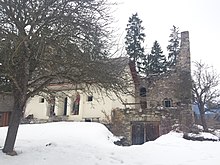Pichl castle ruins
The Pichl castle ruins (also known as the Tannhauser Turm ) are located in the municipality of Mariapfarr in the Lungau of the State of Salzburg (Pichl 10).
history
The castle was the ancestral seat of the Lords of Pichl . Of these, 1123 Reginhard de Püchilarn is mentioned; from the year 1141 a Dionas von Pichleren and 1287 a Heinrich von Pichl is known. Around 1360 the property passed to Hans den Waldecker . This probably comes from Waldegg Castle in Lower Styria. At that time Pichl des Waldegkers was called Thurn and pau zu Pühel . His son Hans II inherits the tower in 1403. In 1450 the property passed to his cousin Alexis, as Hans had died without descendants.
1466 comes Konrad Thannhauser, z. T. by purchase and z. T. by handing over to the tower and the surrounding area. After his death († 1483, buried in the parish church of Mariapfarr ) his son of the same name succeeds him; this was the Salzburg councilor and also the caretaker of Moosham . Around 1485 Pichl came to Balthasar, the brother of Konrad Thannhauser. This is inherited by his son, also with the name Balthasar († 1516). After that the property goes to his brother Franz von Tannhausen. Franz von Tannhausen is known for the Salzburg Peasants' War of 1526. He wanted to rush to the besieged Radstadt with a contingent of 700 men from the Lungau , but was ambushed at the Tauern Pass and lost 200 men and had to turn back. Presumably in revenge for this support of the Salzburg Archbishop Matthäus Lang von Wellenburg , the Lungau farmers set fire to the Pichl Tower. The temporarily orphaned castle was not designated as habitable again until 1546. Franz von Tannhausen dies in 1548 as the vice cathedral of Friesach . In 1630, Karl Jocher, the Lungau trade company, bought the tower and courtyard of Pichl from his heirs . Adam Jocher succeeds him in ownership. In 1659 the property came to his daughter Johanna Maria, married von Plaz, as marriage property; this family is subsequently called von Pichl . These are headquartered in Höch Castle near Flachau , and as a result the Pichl tower was abandoned to decay.
Pichl castle ruins today
The remains of Pichl Castle are in the immediate vicinity of the soup property on the edge of a terrace sloping towards the Taurach . Pichl was a square residential and defense tower typical of the time . A partially four-storey wall made of layered masonry has been preserved. For this spot vorfindbares was glacial - and broken stone material used. The rounded window reveals on the second floor were made in tuff from a deposit in Weißpriach .
In the 19th century a grain box ("Troadkasten") and a cellar were added and a shed (which has since been demolished again) was built on the west side . In the southern entrance to the granary can be found in two niches slightly larger than life wooden figures of St.. George and St. Florian , both were acquired around 1900 in Stadl an der Mur in Styria. In the 20th century, a discharge house was added to the remains of the wall in the east . The castle ruin has been a listed building since 2012 .
There is a chapel on a small hill next to the castle . This was built in 1872 to save the baroque side altars, which were no longer desired during the renovation of the Mariapfarr pilgrimage church .
literature
- Friederike Zaisberger, Walter Schlegel: Castles and palaces in Salzburg. Pongau, Pinzgau, Lungau . Birch series, Vienna 1978, ISBN 3-85030-037-4 .
Web links
- Pichl castle ruins (Tannhauser Turm) on Wehrbauten.at
- Ruin Pichl on ruin empire
- Feature: Square tower by Pichl
Coordinates: 47 ° 8 ′ 17.1 ″ N , 13 ° 44 ′ 5 ″ E


